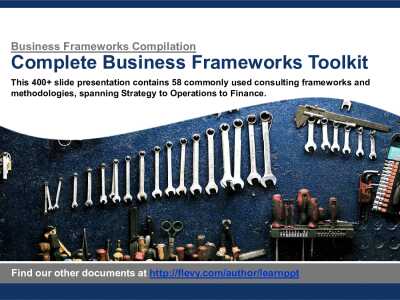Editor's Note: Take a look at our featured best practice, Complete Organization Design Toolkit (103-slide PowerPoint presentation). Recent McKinsey research surveyed a large set of global executives and suggests that many companies, these days, are in a nearly permanent state of organizational flux. A rise in efforts in Organizational Design is attributed to the accelerating pace of structural change generated by market [read more]
* * * *
 You have to find the obstacles, then overcome them… fly over them, dig under them, outflank them to move around them. And it is often the ones that you didn’t see that cause you the biggest problems! Succession planning for family businesses is just like a physical obstacle course.
You have to find the obstacles, then overcome them… fly over them, dig under them, outflank them to move around them. And it is often the ones that you didn’t see that cause you the biggest problems! Succession planning for family businesses is just like a physical obstacle course.
Every family and family business situation is different, so there is no one “master map,” because there are no fixed or defined obstructions. However, certain things do tend to appear frequently, so we’ve compiled our checklist of frequent obstacles. If you look for and deal with these, you will have greatly improved your chances for successful succession.
A couple of notes about this checklist…
- We have used “Dad” to identify a founder or retiring owner.
- The goal is not to determine whether particular obstacles are true or not…
… If the point is perceived to be true or present, then it is an obstacle that has to be dealt with.
Founder or Retiring Owner
- First, and most importantly, Dad must believe his financial security is assured. Without this perception, there is a major obstacle and the probability of Dad leaving the business “voluntarily” is significantly reduced.
- What is Dad going to do with the time and energy he had committed to the business? Obviously Dad must be able to envision a positive, productive, and meaningful existence away from the business. Without having something to “move to,” Dad likely will not “move from.”
- Will the transition diminish Dad’s self-esteem and negatively impact his self-concept? Very often in our society, “who we are” is generally described by “what we do.”
- With regard to the kids, the most perplexing problem for Dad is how can he be both fair and equal.
As a parent, Dad’s instincts are to try and be equal to all his children. That is to say, he does not want to show any partiality to any one child. Yet, as a businessman, he knows the business can not be run well by a committee of his heirs. It is more logical to select one of the children to lead the company into the future. Both facets of this issue produce ample opportunities for Dad to procrastinate or to avoid dealing with the entire concept of succession planning.
- Is the chosen successor ready and able to run the business? If so, how can that be proven?
- The spousal relationship must be considered. Mom’s idea of retirement may not include “sailing a boat around the world.” In other words, even though the wife may not have had a visible role in the planning or the running of the business, she must be included in the planning for the transition to retirement if the process is to be successful.
- Although it is not frequently discussed, Dad’s reservations about his fiduciary responsibility to long-term, non-family employees should be addressed. Who will look after them when Dad is no longer in the business?
- Dad’s friends continue to work in their businesses or jobs.
- Reluctance to give up the power and sense of control.
- Jealousy and/or rivalry toward successor.
- Lack of coaching skills–tendency to focus on immediate problems that can be solved rather than “future” problems.
Family
- Spouse’s role in business.
- Reluctance to discuss the future beyond their parents’ life.
- Fairness versus favoritism.
Employees
- Personal relationship with the founder.
- Differentiating among key managers.
- Reluctance to establish formal controls.
Outsiders – Customers, Suppliers
- Clients or suppliers depend on the founder.
- Clients or suppliers do not trust or have confidence in the potential successor(s).
Success Planning Guidelines
Ideally, succession should be a process and not an event. Start early and think about succession taking place over a three- to five-year period of time using these guidelines:
- Start the process by recognizing the goals and objectives of each of the family members and their spouses.
- Create an advisory board. It’s a great safety net for both the business and the family—especially if a catastrophic event occurs such as the unexpected death of the business owner.
- Pay attention to the “dualism dynamic.” As the management style of the business becomes more professional, the communication system for the family also should become more formalized.
- Plan. Lack of planning is a major contributor as to why only about 30 percent of family businesses successfully transition to the second generation.
- Engage the next generation of owners/managers by using their energy and education.
- Be flexible. Succession planning for a family business is generally described in terms of “transition.” It’s crucial to think of succession as a time of “transformation” for the business. Many family businesses are victims of the tyranny of routine, and they tend to make changes slowly.
- Be grateful. Succession time provides the opportunity for a family business to pass on wealth and wisdom.
- Succession is the time to review all of the policies and practices of how the business is managed and operated, review and assess equipment and technology, analyze and evaluate the customer base, analyze and evaluate the product line, determine how well organized the organization is, and evaluate human capital requirements.

407-slide PowerPoint presentation
This is a very comprehensive document with over 400+ slides--covering 58 common management consulting frameworks and methodologies (listed below in alphabetical order). A detailed summary is provided for each business framework. The frameworks in this deck span across Corporate Strategy,
[read more]
Do You Want to Implement Business Best Practices?
You can download in-depth presentations on Bain PowerPoint and 100s of management topics from the FlevyPro Library. FlevyPro is trusted and utilized by 1000s of management consultants and corporate executives.
For even more best practices available on Flevy, have a look at our top 100 lists:
These best practices are of the same as those leveraged by top-tier management consulting firms, like McKinsey, BCG, Bain, and Accenture. Improve the growth and efficiency of your organization by utilizing these best practice frameworks, templates, and tools. Most were developed by seasoned executives and consultants with over 20+ years of experience.
Readers of This Article Are Interested in These Resources

79-slide PowerPoint presentation
This document provides a holistic approach for undertaking strategic planning. While covering the traditional strategic planning approach, the document touches on adaptations that may be used in an unpredictable environment.
Contents:
1. Strategic Planning Overview
- Key questions and
[read more]

51-slide PowerPoint presentation
Summary: This document provides a framework to design your business strategy.
A key question that every business needs to able to answer is "What is our strategy?"
'Strategy' is part of everyday business language and is often used in the wrong context (e.g. 'Operational
[read more]

33-slide PowerPoint presentation
You may have heard that management consultants spend the majority of their time cranking out PowerPoint slides. There is much truth to do this--and for good reason.
A PowerPoint presentation is not only a great communication tool, it is also the form of most consulting deliverables--i.e. the
[read more]

23-slide PowerPoint presentation
This document presents an overarching structure for a consulting project proposal deck. It includes the high-level presentation flow, as well as specific slide structure and verbiage structure. You can follow it as a general presentation template. Details are more geared towards strategy
[read more]





